VFX Artistry 101: Mastering Composition for VFX Artists
Ultimate Guide To Composition For VFX Artists
Filmmaking is an art form that hinges on the composition of shots. Each frame is meticulously crafted to convey meaning, emotion, and storytelling. In this excellent episode of “The Shot List,” from StudioBinder, they dive deep into the world of composition and explore how various elements come together to create memorable cinematic moments.
Composition: A Brief Definition and History:
Composition is not just about what you include in a frame; it’s about the relationship between those elements that conveys meaning. This concept traces its roots back to the early days of storytelling through single images, where a single frame had to tell a complete story. A well-composed shot can convey characters, situations, power dynamics, drama, themes, and movement, all within a single frame.
Aspect Ratio in Composition:
The size and shape of the image, known as aspect ratio, play a crucial role in composition. Different aspect ratios offer unique opportunities for framing and storytelling. Whether it’s a squarish frame or a rectangular one, understanding how to utilize aspect ratio enhances composition.
Elements of Composition: Points, Lines, and Shapes:
– Points: Focal points within a shot direct the viewer’s eye and are often used in conjunction with the rule of thirds or the golden triangle.
– Lines: Lines create the fundamental building blocks of composition, conveying height, strength, distance, or energy. Leading lines can guide the viewer’s gaze.
– Shapes: Shapes, whether geometric or organic, add visual unity to an image. They can convey order, chaos, or provide frames within frames.
Textures and Patterns:
Textures and patterns add sensations to compositions. They help shape and inform how we perceive an image. Texture can be achieved through lighting and collaboration between cinematographers and production designers. Patterns convey ideas like power, control, or harmony, and breaking patterns can be equally intriguing.
Space and Depth:
Positive and negative space within a frame create different moods and emphasize the subject’s importance. The location of negative space, like headroom or lead room, matters. Depth, achieved through the foreground, middle ground, and background, adds an illusion of three-dimensional space, enhancing storytelling.
Balance:
Balancing elements within the frame is essential for creating visually pleasing compositions. Techniques like the golden ratio, and symmetry help maintain balance. However, breaking these rules can also be effective when you want to evoke unease.
Angles:
Camera angles add perspective to compositions. High angles diminish the subject’s power, while low angles enhance it. Dutch angles create a sense of unease or kinetic energy. Experimenting with angles can drastically affect the mood of a scene.
Color and Tone:
Color and tone play a vital role in directing the viewer’s eye and conveying emotions. Different color schemes (monochromatic, analogous, complementary) evoke different feelings. Tone, determined by brightness and contrast, influences how we perceive an image. Brightly lit subjects against a dark background keep the focus on the subject.
Conclusion:
Mastering composition is a complex but rewarding endeavor in filmmaking. By understanding and combining these various elements of composition, VFX artists can create visually stunning and emotionally resonant shots. Each element contributes to the storytelling process, guiding the viewer’s eye and conveying the intended message.
As you embark on your VFX journey, remember that composition is a powerful tool in your storytelling arsenal. It’s not just about what’s in the frame; it’s about how you arrange it to captivate the audience and convey the narrative.


